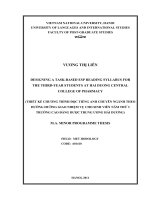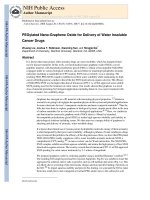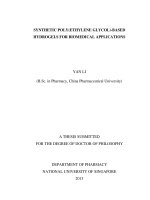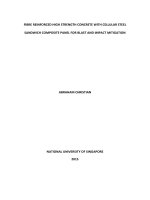Molecular assembly based nano composite structures for memory applications
Bạn đang xem bản rút gọn của tài liệu. Xem và tải ngay bản đầy đủ của tài liệu tại đây (5.86 MB, 270 trang )
MOLECULAR ASSEMBLY BASED NANO-COMPOSITE
STRUCTURES FOR MEMORY APPLICATIONS
RAJU KUMAR GUPTA
NATIONAL UNIVERSITY OF SINGAPORE
2010
MOLECULAR ASSEMBLY BASED NANO-COMPOSITE
STRUCTURES FOR MEMORY APPLICATIONS
RAJU KUMAR GUPTA
(B. Tech., Indian Institute of Technology, Roorkee)
A THESIS SUBMITTED
FOR THE DEGREE OF DOCTOR OF PHILOSOPHY
DEPARTMENT OF CHEMICAL & BIOMOLECULAR
ENGINEERING
NATIONAL UNIVERSITY OF SINGAPORE
2010
i
Dedicated to my mother and my father,
the two most important people in my life,
for their endless love and support.
ii
Acknowledgements
The research work presented in this thesis was carried out at Department of
Chemical and Biomolecular Engineering, National University of Singapore during the
period January 2006 – January 2010. When I look back on my four years at NUS, I
realize how time flies. It was a very valuable and fruitful period for me, although of
course at times I struggled with obstacles and failures. I have learned and experienced
many things at NUS. The completion of this research was in large part due to the support
of many people. I would like to acknowledge some people who have made a major
contribution in completing my Ph.D.
First and foremost, my heartfelt thanks and my deepest appreciation to my
supervisor, Assoc. Prof. Srinivasan Madapusi, P for his incalculable guidance and
direction throughout this research work. It is him who led me to the field of organic
electronics. His patience and timely advice, continuous encouragement and confidence
provided me an inspiration to complete my research work with prolific mode. His
constructive criticisms and numerous suggestions have helped me a lot in getting the
thesis in present form. This thesis would have been a distant goal without his support,
direction and encouragement. His patience and kind understanding has motivated and
spurred me through the long and arduous experiments. Constant words of
encouragement, support, and the invaluable academic interaction which has guided me
from the various “dead-ends” of the project are duly acknowledged. He is also my
learning models of the scientific spirits and positive attitude.
iii
Heartfelt thanks to Dr. Sivashankar Krishnamoorthy from Institute of Materials
Research and Engineering (IMRE), Singapore for his fruitful technical discussions as
well as encouragement for my future academic career.
My sincere thanks to Assoc. Prof. Pooi See, LEE from School of Materials
Science and Engineering, NTU, Dr. AKKIPEDDI Ramam from IMRE, Singapore, Dr.
Jianyong Ouyang from Department of Materials Science and Engineering, NUS and Dr.
Nalam Satyanarayana from Mechanical Engineering department, NUS for their valuable
advices and timely assistance throughout my research.
Due acknowledgement has been made of the research work done by others in
the literature on the organic nonvolatile memory devices over the years, by referring them
appropriately in the respective Chapters of the Thesis. Due to vast amount of literature on
the topic of the Thesis, it has not been possible to quote all the available references and
any omissions are due to oversight or to error in judgment, which may be condoned.
Special thanks to all research staff and lab officers Dr. Rajarathnam, Mr.
Rajamohan, Mr. Chia, Ms. Samantha, Mr. Mao Ning, Ms. Chai Keng, Ms. Novel, Ms.
Yanfang, Ms. Tay Kaisi, Mr. Boey and Dr. Yuan for their help and understanding. I
would like to express my profound thanks to my lab seniors Dr. Zhang Fengxiang and
Dr. Sreenivasa Reddy Puniredd, my lab mates Yeong Sai Hooi, Sundaramurthy
Jayaraman, Huang Meiyu Stella, Ng Su Peng, Vignesh Suresh, Zhou Ruitao and all my
FYP students for rendering their continuous help and for involving directly or indirectly
in my research work.
My heartiest appreciation to all my friends Bipin Kumar, Yogesh Sharma,
Mohan Singh Dhoni, Vishal Sharma, Balaji Parasumanna Gokulan, Atul D Karande and
iv
Sujit Barik for keeping a fruitful and enjoyable environment at home during my stay with
them.
I wish to express my deepest gratitude to Shri Vishnuswaroop Brahamchariji
Maharaj. By his blessings, I always felt enlighten and peace of mind to face the
challenges.
I am indebted to my father (Mr. Naresh Chandra Gupta) and mother (Mrs.
Kasturi Gupta) for their affection, encouragement and support at every stage of my life. I
am extremely thankful to my loved one – Somya who always encouraged and supported
me with her deepest love and ideas during the past several months. I know how proud
they are about my achievements and that makes this PhD degree even more special. I also
wish to acknowledge my brothers (Munish and Anish) for their co-operation and
understanding. Above all, I would like to thank the Almighty, for His kindness, grace and
blessings throughout my career.
I am lucky to have bunch of friends who always kept me cheerful. I would like
to thank Satyen, Bharat, Damar, Dr. Sunil, Dr. Sanjiv, Manish, Sudhir, Niranjani,
Anbharasi, Liu Gang, Poh Hui, Suhanya, Anitha, Danping, Vivek, Karthiga, Prashant,
Ravi, Sivashangari, Dhawal, Prashant Chandrasekharan, Suresh, Sundar, Bibin, Vinayak,
Anjaiah, Rama Rao, Vigneshwar, Dr. Shashi Bhusan, Ashish, Ashvani, Harendra,
Gyanveer, Saurabh, Dr. Naveen, Dr. Amit Gupta, Shweta, Amit Tonk, Anupam, Nidhi,
Shrikant, Goldi, Avinash and Abhishek for their timely assistance, inspiring discussions
and criticisms which helped me to a large extent and made my staying in NUS and
Singapore more enjoyable and memorable.
v
I would like to thank the National University of Singapore for providing me
financial support in the form of research scholarship and an excellent research
environment throughout my candidature.
Lastly, I wish to thank the people who have helped me in one way or another
that I might have missed out.
vi
TABLE OF CONTENTS
Dedication i
Acknowledgements ii
Table of Contents vi
Summary xii
Nomenclature xvii
List of Figures xix
List of Schemes and Tables xxv
Chapter 1 Introduction 1
Chapter 2 Literature Review 9
2.1 Electronic Memory 10
2.2 Types of Electronic Memory 10
2.3 Flash Memory 11
2.3.1 Operation Mechanism for Nanocrystal Based Memory Devices 13
2.3.1.1 Fowler-Nordheim Tunneling 14
2.3.1.2 Channel Hot Electron Injection 15
2.4 Organic Electronics 17
2.4.1 Organic Based Memory Devices 17
2.4.2 Organic and Nanoparticle Based Hybrid Memory Devices 19
2.5 Polyimide Film 24
2.5.1 Polyimide Films for Memory Devices 24
2.5.2 Nanoparticles Embedded Polyimide Films for Memory Devices 25
2.6 Motivation for the Present Study 26
2.7 Device Fabrication Methods 27
2.7.1 Spin Coating Technique 27
2.7.2 Langmuir-Blodgett Films 28
2.7.3 Electrostatic LbL Films 29
2.7.4 Covalent Assembly 30
2.8 Fabrication Methods for Nanoparticle Containing Hybrid Structures 30
vii
2.8.1 Spin Coating Technique Based 30
2.8.2 Assembly Based 31
2.8.2.1 Langmuir-Blodgett Assembly Based 31
2.8.2.2 Electrostatic Assembly Based 33
2.8.2.3 Covalent Assembly Based 34
2.8.2.4 Dendrimers Based 35
2.9 Large Area Memory Devices 40
2.9.1 Nanoparticles on Patterned Surfaces 40
Chapter 3 Copper Nanoparticles Embedded in a Polyimide Film for Nonvolatile
Memory Applications 42
3.1 Introduction 43
3.2 Experimental Section 43
3.2.1 Materials 43
3.2.2 Substrate Preparation 44
3.2.3 Preparation of poly (amic acid) 44
3.2.4 Preparation of poly (amic acid) Films 46
3.2.5 Introduction of Copper Precursor 46
3.2.6 Polyimide Conversion through Chemical Imidisation in Benzene 47
3.2.7 Reduction of Copper Precursor 47
3.2.8 MIS Capacitor Fabrication 47
3.2.9 Characterization 48
3.3 Results and Discussions 50
3.3.1 X-Ray Photoelectron Spectroscopy 50
3.3.2 Surface Morphology 52
3.3.3 Field Emission Scanning Electron Microscopy 52
3.3.4 Capacitance–voltage (C–V) and Capacitance–time (C–t) Analysis 54
3.4 Conclusions 61
Chapter 4 Langmuir−Blodgett Assembly of 4-Methylbenzenethiol Functionalized
Gold Nanoparticles for Nonvolatile Memory Applications 62
4.1 Introduction 63
4.2 Experimental Section 63
viii
4.2.1 Materials 63
4.2.2 Synthesis of Thiol-Stabilized Gold Nanoparticles 64
4.2.3 Immobilization on Silicon Surface 64
4.2.3.1 Substrate Preparation 64
4.2.3.2 Self-Assembly of Silane 65
4.2.3.3 LB Film Deposition of Gold Nanoparticles 65
4.2.4 MIS Capacitor Fabrication 66
4.2.5 Characterization 66
4.3 Results and Discussions 68
4.3.1 Synthesis of MBT Capped Gold Nanoparticles 68
4.3.1.1 Transmission Electron Microscopy (TEM) 68
4.3.2 LB Assembly of Gold Nanoparticles 70
4.3.2.1 Ellipsometric Characterization 70
4.3.2.2 Surface Morphology 70
4.3.3 C–V Analysis 72
4.4 Conclusions 80
Chapter 5 Covalent Assembly of Functionalized Gold Nanoparticles 81
5.1 Synthesis of Short Chain Thiol Capped Gold Nanoparticles, their Stabilization and
Immobilization on Silicon Surface 84
5.1.1 Introduction 85
5.1.2 Experimental Section 85
5.1.2.1 Materials 85
5.1.2.2 Synthesis of Thiol-Stabilized Gold Nanoparticles 86
5.1.2.3 Stabilization of Thiol-Capped Gold Nanoparticles 88
5.1.2.4 Immobilization on Silicon Surface 88
5.1.2.5 Characterization 89
5.1.3 Results and Discussions 92
5.1.3.1 Synthesis and Stabilization of 4-ATP Capped Gold Nanoparticles 92
5.1.3.2 Immobilization of Stabilized Gold Nanoparticles 101
5.1.4 Conclusions 104
5.2 Synthesis of 16-Mercaptohexadecanoic Acid Capped Gold Nanoparticles and their
ix
Immobilization on a Substrate 105
5.2.1 Introduction 106
5.2.2 Experimental Section 106
5.2.2.1 Materials 106
5.2.2.2 Synthesis of Thiol-Stabilized Gold Nanoparticles 107
5.2.2.3 Immobilization on Silicon Surface 108
5.2.2.4 Characterization 110
5.2.3 Results and Discussions 110
5.2.3.1 Synthesis 16-MHDA Capped Gold Nanoparticles 110
5.2.3.2 Immobilization of Acid Terminated Gold Nanoparticles 117
5.2.4 Conclusions 123
5.3 Covalent Assembly of Gold Nanoparticles for Nonvolatile Memory
Applications 124
5.3.1 Introduction 125
5.3.2 Experimental Section 125
5.3.2.1 Materials 125
5.3.2.2 Synthesis of Thiol-Stabilized Gold Nanoparticles 126
5.3.2.3 Immobilization on Silicon Surface 127
5.3.2.4 MIS Capacitor Fabrication 128
5.3.2.5 Characterization 128
5.3.3 Results and Discussions 131
5.3.3.1 Synthesis of MUD Capped Gold Nanoparticles 131
5.3.3.2 Immobilization of MUD Capped Gold Nanoparticles 134
5.3.3.3 C-V and C-t Analysis 138
5.3.4 Conclusions 141
Chapter 6 Hybrid Multilayer Assembly of Functionalized Gold Nanoparticles and
Thin Polymeric Films 143
6.1 Optimization for Deposition of Covalently Bound Ultrathin Polymer Films: An
Example for Improvement to Wear Life 146
6.1.1 Introduction 147
6.1.2 Experimental Section 147
x
6.1.2.1 Materials 147
6.1.2.2 Immobilization on Silicon Surface 148
6.1.2.3 Characterization 151
6.1.3 Results and Discussions 152
6.1.3.1 Surface Morphology 152
6.1.3.2 Ellipsometric Characterization 154
6.1.3.3 X-ray Photoelectron Spectroscopy (XPS) 154
6.1.3.4 Tribology 156
6.1.4 Conclusions 162
6.2 Multilayer Assembly of Gold Nanoparticles and their Controlled Separation on
Silicon Substrate through Covalently Bound Multilayer of Ultrathin Polymer
Films 163
6.2.1 Introduction 164
6.2.2 Experimental Section 164
6.2.2.1 Materials 164
6.2.2.2 Multilayer of Gantrez Film Deposition 165
6.2.2.3 Synthesis of Citrate Stabilized Gold Nanoparticles 167
6.2.2.4 Immobilization of Citrate Gold Nanoparticles 167
6.2.2.5 Immobilization of Multilayer of Citrate Gold Nanoparticles 167
6.2.2.6 Characterization 169
6.2.3 Results and Discussions 171
6.2.3.1 Multilayer of Gantrez Film 171
6.2.3.2 Immobilization of Citrate Stabilized Gold Nanoparticles 174
6.2.4 Conclusions 182
Chapter 7 Tailored Assembly of Gold Nanoparticles over Patterned Surface for
Nonvolatile Memory Applications 183
7.1 Introduction 184
7.2 Experimental Section 184
7.2.1 Materials 184
7.2.2 Synthesis of Citrate Stabilized Gold Nanoparticles 185
7.2.3 Immobilization on Silicon Surface 185
xi
7.2.3.1 APhS Deposition on Substrate 185
7.2.3.2 ATP Deposition on Patterned Substrate 186
7.2.3.3 Immobilization of Gold Nanoparticles 186
7.2.4 MIS Capacitor Fabrication 186
7.2.5 Characterization 186
7.3 Results and Discussions 188
7.3.1 Synthesis of Citrate Capped Gold Nanoparticles 188
7.3.1.1 Transmission Electron Microscopy (TEM) 188
7.3.2 Immobilization of Citrate Capped Gold Nanoparticles 188
7.3.2.1 Surface Morphology 188
7.3.2.2 FESEM Analysis 190
7.3.3 C–V Analysis 193
7.4 Conclusions 197
Chapter 8 Conclusions 200
Chapter 9 Future Recommendations 205
References 209
Appendix 241
xii
Summary
Today, memory devices with faster access time, easily processable, less power
consumption, longer retention time, enhanced stability and importantly low cost are on
demand for current electronic industry. Organic based memory devices have attracted
considerable attention due to their low cost and easy processing. Self-assembly
techniques that allow the controlled growth of nanometer-scale organic molecular films
which eventually leads simple processing and device fabrication and present new
opportunities to develop electronic devices with dimensions much smaller than those of
current technologies. However, processing technology on a nano-scale is immature and
continuous development is required.
The metal nanoparticles could be exploited as potential storage elements for nonvolatile
memory device applications such as metal/insulator/semiconductor (MIS) memory
structures using nanocrystals embedded in a dielectric material. The recent interest in
nanofloating gate MIS memory structures starts largely from their potential application in
future memory market, since assembled layer of metal nanoparticles functioning as a
floating gate can reduce the charge loss problem encountered with the conventional flash
memories. This will lead to reduced power consumption, increased write/erase speed and
increased device density. Currently, most of the memory devices employ incorporation of
metals nanoparticles through thermal evaporation of metal which leads to random
distribution of metal nanoparticles inside a dielectric. In addition, there is not any control
over ordering, organization and size of the nanoparticles used in such memory devices.
Shortcomings of non-uniformity in size and shape of metallic nanoparticles in these
xiii
memory devices can be overcome by incorporating pre-synthesized nanoparticles in the
devices. The self-assembly of pre-formed nanoparticles using spin-coating technique
either suffer from random distribution of the nanoparticles or lack of uniformity when
coated on large areas.
The objective of this Ph.D thesis is to improve performance of current memory devices
fabricated using spin coating technique through polyimide films to give better thermal
stability to memory devices and to develop molecular assembly based thin films of
organic and organo-metallic structures for nonvolatile memory applications. Techniques,
based on Langmuir-Blodgett deposition and electrostatic assemblies are able to produce
multilayer films with controlled thickness, tailored structure or desired functionality. In
terms of stability or strength, multilayer films with covalent interlayer bonding are more
advantageous over Langmuir-Blodgett and electrostatic bonding, since they are robust
enough to withstand elevated temperatures, polar solvent attack, mechanical wear and
abrasion.
Nonvolatile organic bistable devices, that utilize solution processed uniformly distributed
copper nanoparticles in polyimide matrix, have been fabricated and their unique
nonvolatile electrical bistability properties are discussed. Copper acetylacetonate
(Cu(acac)
2
) as a precursor has been used. Polymer memory device was fabricated by spin
coating solution containing polyamic acid and the nanoparticle precursors. The
precursors were subsequently thermally reduced to form the nanoparticles. The resulting
films were then characterized by X-ray photoelectron spectroscopy (XPS), atomic force
xiv
and scanning electron microscopies. Capacitance-voltage measurements showed that the
embedded Cu nanoparticles functioning as a floating gate in metal-insulator-
semiconductor-type capacitor exhibits a hysteresis window of 1.52 V at an applied
voltage of 8 V.
The Langmuir-Blodgett technique of molecular assembly has been employed in
fabricating a multilayered array of gold nanoparticles functionalized by
4-methylbenzenethiol on Si substrates. The 2 layer, 4 layer and 6 layer structures of
functionalized gold nanoparticles (AuNPs) were fabricated. Thickness measurements by
ellipsometry showed a linear increase of film thickness with the number of layers,
indicating a reproducible deposition process. The capacitance versus voltage
characteristics of these devices showed increment in hysteresis window with the number
of layers.
Short chain thiol (4-aminothiophenol)-capped AuNPs functionalized with amine-
termination have been synthesized, and changes in their morphology by varying the
process conditions as well as the dispersion medium were studied. Subsequently, the
nanoparticles (which are prone to agglomerate due to amine-amine hydrogen bonding)
were stabilized in solution and by anhydride capping. Finally, these stabilized
nanoparticles were immobilized on a silicon substrate. The cross-sectional high
resolution transmission electron microscopy (HR-TEM) images directly indicated that the
particles are anchored to the silicon surface.
xv
16-mercaptohexadecanoic acid capped AuNPs with a narrow size distribution have been
synthesized through a single phase synthesis method and subsequently immobilized onto
silicon/gold surfaces through covalent molecular assembly. Fourier transform infrared
spectroscopy and XPS confirmed the absence of unreacted thiol in the synthesized
AuNPs. Presence of AuNPs on silicon surface, after the immobilization process, was
confirmed through XPS. Cross-sectional HR-TEM images provided direct evidence that
the particles are indeed anchored to the silicon surface.
Gold nanoparticles bearing pendant alcohol functional groups have been synthesized with
a narrow size distribution (diameter ∼5 nm). Later, these nanoparticles were immobilized
on a silicon substrate using a functionalized polymer as a surface modifier. Microscopic
and spectroscopic techniques were used to characterize the nanoparticles and their
morphology before and after immobilization. In addition, the electrical characterization
of covalently bound AuNPs, as a charge trapping layer in nonvolatile memory was also
investigated by means of a metal-insulator semiconductor device structure.
The application of covalent molecular assembly in fabricating robust thin film multilayer
structures has been demonstrated. An anhydride functionalized polymer was deposited
over an amine-terminated silane, which was assembled on a silicon surface through
covalent binding. Multilayers of polymers were obtained by using a diamine molecule as
a spacer that is covalently bound to adjacent polymer layers. The thickness and surface
morphology of the covalently bound polymer layers were characterized with ellipsometry
and atomic force microscopy. Later, we present a new synthetic strategy to build
xvi
multilayered composite films comprising functionalized polymer and AuNPs. AuNPs are
stabilized and immobilized through electrostatic binding between a functionalized
polymer and gold nanoparticle (AuNP). The assembly process allows placement of AuNP
layers with controlled inter-layer separation using covalently bound spacers.
Characterizations, performed by spectroscopic (XPS) and microscopic (Field emission
scanning electron microscopy and cross-sectional HR-TEM) methods showed the
positioning of the AuNP layers and uniform distribution of the nanoparticles over the
surface.
The combination of block copolymer directed synthesis and electrostatic self-assembly of
AuNPs was used to achieve the assemblies. This helped to create size-tunable particle
arrays of metal nanoparticles down to sub-10 nm dimensions with narrow dispersion,
high density and excellent homogeneity over large areas. The nanoparticle assemblies are
demonstrated to significantly benefit from a high charge storage capacity, as well as ease
of charge-injection. The resulting AuNP assembled structures displayed improved charge
storage over patterned gold substrate. Charge storage capacity was also enhanced by
increasing the density of AuNPs via increasing the deposition time.
xvii
NOMENCLATURE
AFM
Atomic force microscopy
APhS
p-Aminophenyltrimethoxysilane
ATP
Aminothiophenol
AuNPs
Gold nanoparticles
BE
Binding energy
CPS
3-cyanopropyltrichlorosilane
Cu(acac)
2
Copper acetylacetonate
C–V
Capacitance–voltage
DADA
1, 12-diaminododecane
DDE
Diaminodiphenyl ether
DMAc
N,N’-dimethylacetamide
DMF
N,N’-dimethylformamide
DRAM
Dynamic random-access memory
eV
Electron volt
FESEM
Field emission scanning electron microscopy
FTIR
Fourier transform infrared spectroscopy
HDD
Hard disk drive
HR-TEM
High resolution transmission electron microscopy
LB
Langmuir-Blodgett
LbL
Layer-by-layer
MBT
Methylbenzenethiol
xviii
MHDA
Mercaptohexadecanoic acid
MIS
Metal-insulator-semiconductor
MOSFET
Metal oxide field effect transistor
MUD
11-mercapto-1-undecanol
NPs
Nanoparticles
OBDs
Organic bistable devices
OTS
Octadecyltrichlorosilane
PAA
Poly(amic acid)
PDA
1, 4-phenylene diamine
PI
Polyimide
PMDA
Pyromellitic dianhydride
rpm
Revolutions per minute
SAM
Self-assembled monolayer
SRAM
Static random access memory
TEM
Transmission electron microscopy
TGA
Thermogravimetric analysis
THF
Tetrahydrofuran
TOAB
Tetraoctylammonium bromide
UV
Ultraviolet-visible
VASE
Variable angle spectroscopic ellipsometry
WORM
Write-once read-many times
XPS
X-ray photoelectron spectroscopy
xix
List of Figures
Figure 2.1. (a) Schematic diagram of a nanocrystal memory structure and (b) schematic
diagram of a memory cell with nanocrystals as discrete charge storage elements.
Figure 2.2. Schematic band diagram of a nanocrystal (NC) memory structure with SiO
2
as the tunneling dielectric and Al
2
O
3
as the control dielectric under (a) write state
(positive applied bias), (b) retention state and (c) erase state (negative applied bias).
Figure 3.1. Schematic of MIS device structure.
Figure 3.2. XPS wide scans for copper nanoparticle containing PI film. (A) 1 day after
reduction (B) 15 days after reduction.
Figure 3.3. Surface topography for copper nanoparticles embedded PI film. (A) height
image, (B) phase image and (C) section analysis.
Figure 3.4. FESEM images for copper nanoparticles embedded PI film. (A), (B)
Reduction before chemical imidisation step; (C), (D) Reduction after chemical
imidisation step.
Figure 3.5. Normalized C-V characteristics at 100 kHz obtained by biasing the top
electrodes at ± 2 V for control sample (without CuNPs) and with CuNPs.
Figure 3.6. Normalized C-V characteristics at 100 kHz obtained by biasing the top
electrodes at ± 5 V for control sample (without CuNPs) and with CuNPs.
Figure 3.7. C–V characteristics at 100 kHz under different scan voltage ranges for an
MIS capacitor incorporating copper nanoparticles.
Figure 3.8. Charge retention characteristics (normalized capacitance) of the MIS device
at 100 kHz after programming at + 5 V.
Figure 4.1. The MIS device configuration for the multilayer of MBT capped gold
nanoparticles.
xx
Figure 4.2. TEM image of MBT capped gold nanoparticles.
Figure 4.3. Ellipsometric thickness of MBT capped gold nanoparticles films prepared by
LB deposition versus number of layers.
Figure 4.4. Surface topographies of 2 µm × 2 µm regions for different deposition steps
(A) OTS surface, (B) 2 layer of nanoparticles, (C) 4 layer of nanoparticles and (D) 6 layer
of nanoparticles.
Figure 4.5. A comparison of section analysis at various deposition steps (A) OTS
surface, (B) 2 layer of nanoparticles, (C) 4 layer of nanoparticles and (D) 6 layer of
nanoparticles.
Figure 4.6. Normalized C-V characteristics at 100 kHz obtained by biasing the top
electrodes at ± 5 V for control sample (without nanoparticles) and with 4 Layer of MBT
capped AuNPs.
Figure 4.7. Normalized C-V characteristics at 100 kHz obtained by biasing the top
electrodes at ± 7 V to compare effect of number of layer of MBT capped AuNPs.
Figure 4.8. Normalized C–V characteristics at 100 kHz under different scan voltage
ranges for an MIS capacitor incorporating 4 Layer of MBT capped AuNPs.
Figure 4.9. Normalized C–V characteristics at ± 5 V to compare effect of frequency for 4
Layer of MBT capped AuNPs.
Figure 5.1.1. Schematic for immobilization of anhydride functionalized gold
nanoparticles on to a hydroxyl-terminated silicon surface.
Figure 5.1.2. UV-visible absorption spectra of gold nanoparticles synthesized (A) effect
of synthesis method (B) effect of dispersion media.
Figure 5.1.3. UV-visible absorption spectra of gold nanoparticles of DMAc dispersion
after reaction of various amounts of nanoparticles with 5 mL of 5 mM.
xxi
Figure 5.1.4. X-ray photoelectron spectra of 4-ATP capped gold nanoparticles through
mixed approach showing the (A) N 1s region and the (B) S 2p region.
Figure 5.1.5. X-ray photoelectron spectra of gold nanoparticles stabilized with PMDA
showing the (A) C 1s region and the (B) N 1s region.
Figure 5.1.6. TEM images for gold nanoparticles (A) synthesized gold nanoparticles
through mixed approach (B) 0.25 µmoles of gold nanoparticles after reaction with PMDA
(C) 0.05 µmoles of gold nanoparticles after reaction with PMDA (D) 0.025 µmoles of
gold nanoparticles after reaction with PMDA.
Figure 5.1.7. X-ray photoelectron wide spectra. (A) APhS-modified Si substrate, (B)
gold nanoparticles immobilized on Si substrate, (C) Au 4f
7/2
and 4f
5/2
spectra of gold
nanoparticles immobilized on Si substrate.
Figure 5.1.8. Cross-sectional HR-TEM image of gold nanoparticles immobilized on Si
substrate.
Figure 5.2.1. FTIR spectra for 16-MHDA capped gold nanoparticles synthesized by
different methods.
Figure 5.2.2. TEM images for 16-MHDA capped gold nanoparticles synthesized by (A)
Method A - carried out at room temperature (B) Method B – carried out at 0
o
C.
Figure 5.2.3. UV-visible absorption spectra of 16-MHDA capped gold nanoparticles
synthesized by different methods in DMAc.
Figure 5.2.4. X-ray photoelectron spectra of 16-MHDA capped gold nanoparticles
synthesized by Method B – carried out at 0
o
C showing the (a) C 1s region, (b) S 2p
region and (c) Au 4f region.
Figure 5.2.5. TEM images for (A) 16-MHDA monolayer deposited gold grid and (B) 16-
MHDA capped gold nanoparticles immobilized on gold grid.
Figure 5.2.6. X-ray photoelectron wide spectra. (A) gold nanoparticles immobilized on
Si substrate; (B) CPS-COOH modified Si substrate.
xxii
Figure 5.2.7. Cross-sectional HR-TEM images for (A) Si substrate without gold
nanoparticles; (B) 16-MHDA capped gold nanoparticles immobilized on Si. The inset
shows the enlarged view of immobilized gold nanoparticles.
Figure 5.3.1. The MIS device configuration for the immobilized MUD capped gold
nanoparticles.
Figure 5.3.2. (a) TEM image of MUD capped gold nanoparticles, (b) size distribution of
MUD capped gold nanoparticles.
Figure 5.3.3. X-ray photoelectron spectra of MUD capped gold nanoparticles showing
the (a) C 1s region, (b) S 2p region and (c) Au 4f region.
Figure 5.3.4. C1s core-level XPS spectra at various steps of the AuNPs assembly; (a) the
gantrez deposited APhS substrate, (b) MUD capped AuNPs immobilized on Si substrate.
Figure 5.3.5. Tapping mode AFM images (2 × 2 µm
2
) and z profiles of a gantrez
deposited Si surface (A) and similar surface after immobilization of MUD capped gold
nanoparticles (B).
Figure 5.3.6. FESEM images for MUD capped AuNPs immobilized on Si surface: after
rinsing (a), after 5 min sonication (b).
Figure 5.3.7. FESEM images for MUD capped AuNPs solution spin coated Si surface:
before sonication (a), after 5 min sonication (b).
Figure 5.3.8. Normalized C-V characteristics at 100 kHz obtained by biasing the top
electrodes at ± 6 V for control sample (without gold nanoparticles) and with gold
nanoparticles.
Figure 5.3.9. Normalized C–V characteristics at 100 kHz under different scan voltage
ranges for an MIS capacitor incorporating gold nanoparticles.
Figure 5.3.10. Charge retention characteristics (normalized capacitance) of the MIS
device at 100 kHz after programming at + 5 V.
xxiii
Figure 6.1.1. Surface topographies (2 × 2 µm
2
) for different deposition steps: (a) APhS;
Gantrez deposition for (b) 0.2% and 1 h deposition time; (c) 0.2% and 3 h deposition
time; (d) 0.5% and 1 h deposition time; (e) 0.5% and 3 h deposition time; (f) 1% and 1 h
deposition time.
Figure 6.1.2. Comparison of average thickness for gantrez deposition at different
processing steps.
Figure 6.1.3. C1s core-level XPS spectra for different deposition steps: (A) gantrez
deposition for 0.2% and 3 h deposition time; (B) gantrez deposition for 0.5% and 1 h
deposition time.
Figure 6.1.4. C1s core-level XPS spectra for different deposition steps: (A) gantrez
deposited surface; (B) PFPE deposited surface.
Figure 6.2.1. Ellipsometric thickness of gantrez film versus number of layers.
Figure 6.2.2. TEM image of gold nanoparticles.
Figure 6.2.3. FESEM images for citrate AuNPs immobilized on amine terminated Si
surface. (A) APhS; (B) 1
st
layer of DADA; (C) 2
nd
layer of DADA; (D) 3
rd
layer of
DADA.
Figure 6.2.4. Cross-sectional HR-TEM images for (A) citrate stabilized AuNPs on APhS
deposited Si surface; (B) citrate stabilized AuNPs on 2
nd
layer of DADA deposited Si
surface.
Figure 6.2.5. FESEM images for (A) citrate stabilized AuNPs on APhS; (B) citrate
stabilized AuNPs on APhS after immersion in pH 10 buffer solution; (C) citrate
stabilized AuNPs on APhS stabilized by gantrez film; (D) citrate stabilized AuNPs on
APhS stabilized by gantrez film after immersion in pH 10 buffer solution.
Figure 6.2.6. Cross-sectional HR-TEM images for: 1
st
layer of citrate stabilized AuNPs
on APhS deposited Si surface (A), (B); 2
nd
layer of citrate stabilized AuNPs on DADA
deposited gantrez polymer film on Si surface (C), (D).
Figure 7.1. The MIS device configuration for the immobilized citrate capped gold
nanoparticles.

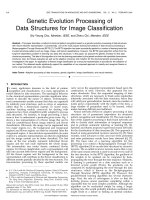
![drupal 7 primer [electronic resource] creating cms-based websites a guide for beginners](https://media.store123doc.com/images/document/14/y/nl/medium_nlq1401353154.jpg)
![in-memory data management [electronic resource] an inflection point for enterprise applications](https://media.store123doc.com/images/document/14/y/jr/medium_jro1401472498.jpg)
